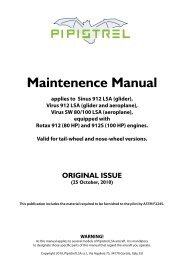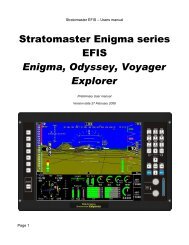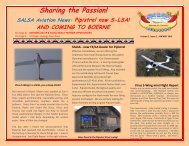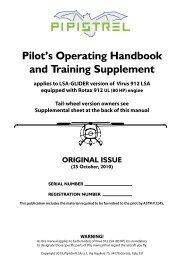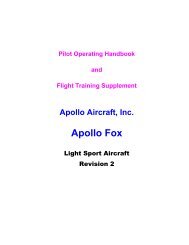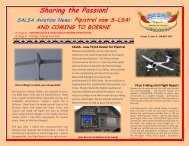Pipistrel Virus Aircraft Operating Instruction - Salsa Aviation
Pipistrel Virus Aircraft Operating Instruction - Salsa Aviation
Pipistrel Virus Aircraft Operating Instruction - Salsa Aviation
Create successful ePaper yourself
Turn your PDF publications into a flip-book with our unique Google optimized e-Paper software.
AIRCRAFT OPERATING INSTRUCTIONS – VIRUS 912 S-LSA GLIDERand initial climb! Having lifted off the ground, gently push the stick forward just a bit to accelerate. Atsome 90 km/ h (50 kts) set flaps to 1st stage, at 110 km/h (60 kts) set them to neutral.ClimbA comfortable setting for climb is flaps in neutral position, speed of 70 kts (130 km/h) at or slightly below5500 RPM. In summer time or when outside temperature exceeds 30°C you should consider climbing atsome 85 kts (160 km/h) to provide more airflow to the engine radiators. Trim the aircraft for comfortablestick forces.CruisePassing through 85 kts (160 km/h), set flaps to negative position (handle full down). A comfortable cruisesetting is 5300 engine RPM. As the <strong>Virus</strong> is sensitive to flap settings, especially when it comes to fuelefficiency, ALWAYS use negative stage of flaps beyond 85 kts (160 km/h) and neutral for level flight below70 kts (130 km/h).Cruising fast, do not kick-in rudder for turns! Above 85 kts (160 km/h) the rudder becomes almostinsignificant in comparison to aileron deflections when it comes to making a turn. Cruising fast, it isextremely important to fly coordinated (ball in the middle) as this increases efficiency and de-creasesside-pressure onto vertical tail surfaces. Also, pay attention to turbulence. If you hit turbulence at speedsgreater than VRA, reduce power immediately and pull the nose up to reduce speed. If flying a trafficpattern, keep flaps in neutral position and set engine power so that airspeed does not exceed 80 kts.DescentDescending with the <strong>Virus</strong> is the stage of flight where the most care should be taken. As the aircraft isessentially a glider, it is very slippery and builds up speed very fast. Start the descent by reducing throttleand keep your speed below V A . During initial descent it is recommended you trim for a 10 kts lowerspeed than the one you decided to descent at. Do this for safety. In case you hit turbulence simplyrelease forward pressure on the stick and the aircraft will slow down. Also, keep in mind that you needto begin your descent quite some time before reaching your destination. A comfortable rate of descentis 500 fpm (2.5 m/s). So it takes you some 2 minutes for a 1000 ft (300 m) drop. At 105 kts (200 km/h)this means 3.6 NM for each 1000 ft drop.Entering the traffic pattern the aircraft must be slowing down. In order to do this, hold your altitude andreduce throttle to idle. When going below 80 kts (150 km/h), set flaps to neutral position. Set properengine RPM to maintain speed of 70 kts (130 km/h). Trim the aircraft for comfortable stick forces. Beforeturning to base-leg, reduce power to idle and set flaps to 1st stage at 60 kts (110 km/h). Once out of theturn, reduce speed towards 55 kts (100 km/h). Power remains idle from the point of turning base all theway to touch-down. If you plan your approach this way, you will always be on the safe side - even if yourengine fails, you will still be able to safely reach the runway!Turn to final at 55 kts (100 km/h). When in runway heading, set flaps to 2nd stage. Operate the air-brakesto obtain the desired descent path (if applicable).How to determine how much airbrakes you need for a certain airspeed?Open them half-way and observe the runway. If the runway threshold is moving up, you are dropping toofast - retract the airbrakes a little. If the runway threshold is disappearing below your aircraft, you aredropping too slowly - extend airbrakes further. When working on airbrakes, it is important to keep theairspeed/pitch angle constant throughout final all the way to flare! The airbrakes will not impact yourspeed, just rate (angle) of descent. For pilots who are not used to operating airbrakes but throttlePage 46



